
|   |

|   |
Guru Darshana Jhaveri blesses Mumbaikars with memorable 'Guru Pratistha' - Sumana Sachidananda e-mail: sumanas29@gmail.com March 14, 2025 They say 60 is the new 50, 50 the new 40 and so onů but for 85-year-old legendary Manipuri exponent Guru Darshana Jhaveri, 85 is the new 35! This artiste who has achieved it all - fame, awards, goodwill, and veneration - continues to inspire all around her with her sheer aura and artistry. 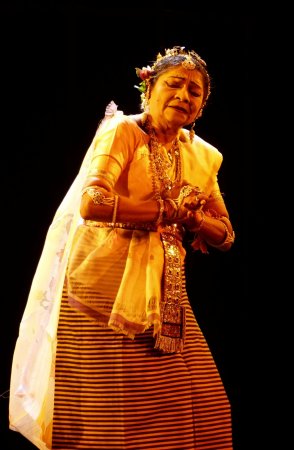 Darshana Jhaveri Darshana Jhaveri presented a heartwarming evening of Manipuri on the 6th of March at the NMACC, Mumbai, along with her disciples Sanjib Bhattacharya, Purbita Mullick, Jhinuk Roy Chakraborty and Susmita Bhowmick. It was titled 'Guru Pratistha' to emphasize the importance of the Guru-Shishya Parampara amongst the younger generation, and as a tribute to her Guru Bipin Singh. Guru Bipin Singh's pioneering approach of amalgamating elements of the two main traditions of Manipuri-Raas and Sankirtan, has given it the structure we see today. After undertaking an in-depth study of both traditions under his Guru Amudon Sharma, along with researching the ancient Shastras, Guru Bipin Singh shaped a unique repertoire that was comprehensive and appealing to the rasika. He brought to light a significant correlation between the oral traditions of Raas and Sankirtan and the Vaishnavite Sangeet shastras. Thereby, he was able to establish the scientific tenets underlying the rich oral traditions. As a visionary, he was instrumental in developing Manipuri and bringing it from the temple courtyard to the proscenium stage. 'Guru Pratistha' began with Darshana Jhaveri introducing Manipuri through the eyes of her Guru, as illustrated in beautiful archival videos. The videos provided a glimpse of the temple traditions of Manipuri. Sankirtan which is performed by the Gaudiya Vaishnavite men with the Pung (drum) and Kartal, forms an integral part of the Manipuri Meitei ethos, featuring in every ritual be it a naming ceremony, wedding or even a funeral. The Manipuri rasikas are essentially devotees of Lord Krishna who are moved to tears by the sounds and movements of this Sankirtan, to the extent of offering cloth and money in gratitude. Performed as a "Mahayagya", Sankirtan has evolved from the core of the Bhakti movement founded by Sri Chaitanya Mahaprabhu and is regarded as the path to uniting with the "Yugal Murti" of Radha and Krishna. The video of the evergreen Raas, featured two angelic children as Radha and Krishna surrounded by innumerable adult Gopis. (Would you believe that this Raas goes on for at least 7 - 8 hours in the midst of hundreds of devotees, who are not only knowledgeable but also immersed in Bhakti?). Darshana Jhaveri has a calm and affectionate demeanour, with an occasional shy giggle that can melt hearts. Her eloquence adds to the overall appeal of the presentation, making it much easier for the audience to grasp the nuances of Manipuri. 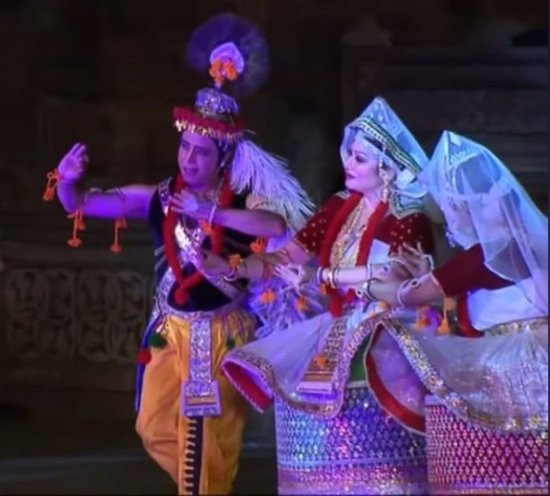 Vasanta Raas The first performance of the evening was "Vasanta Raas". What a lovely prelude to the festival of Holi! In the Manipuri Vaishnavite tradition, the Pancha Rasas or the 5 dominant rasas include Shanta, Dasya, Sakhya, Vatsalya and Madhura. The Madhura Rasa flourishes as the significant one in the depiction of Radha and Krishna in Raas, while the others play an auxiliary role. A charming Krishna surrounded by Radha and Gopis pranced, glided and swayed across the stage bringing alive the colourful festival of spring. What might seem like a whole lot of wavy, curvy movements to the layman, is in reality a highly specialised vocabulary that must be performed with great precision. Right from the delicate turns of the wrists and the measured tapping of the feet, to the crisp spins that look weightless, Manipuri as a form is anything but "light". Only decades of sadhana can achieve what the dancers presented. In today's world, when Holi has become synonymous with uncouth behaviour, here was the most dignified, civilized and sparkling Holi Kreeda Raas there could be! 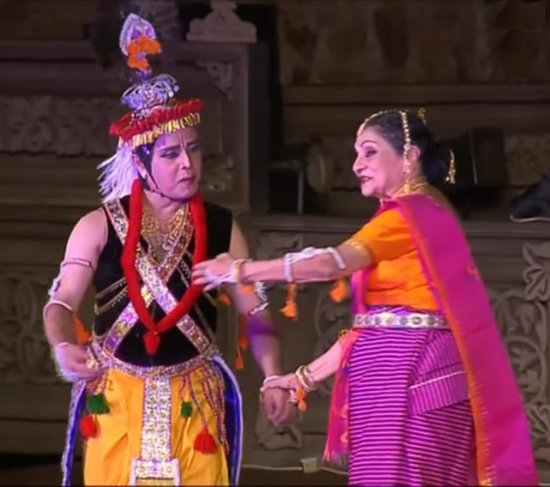 Maan Bhanjan This was followed by "Maan Bhanjan"- a portrayal of the Khandita nayika (the broken or the wronged heroine) from Jayadeva's Geeta Govinda ashtapadis, by the queen herself essaying the role of Radha, alongside her disciple Sanjib who became Krishna. Radha has been waiting for Krishna all night, and to her dismay, he returns after a night of making love to another woman. She is heartbroken and furious to see the marks of love play on his body and rejects his advances. A remorseful Krishna asks for forgiveness by pleading with her and glorifying her beauty. He finally manages to win her over when he says "mama shirasi mandanam dehi pada pallavam udaram", meaning "offer the fresh buds of your enchanting feet as an ornament upon my head". The emotions of the raging Radha who can't be cross with her lover Krishna for too long were delineated impeccably by Darshana Jhaveri. Sanjib was convincing as the guilt-ridden lover Krishna. 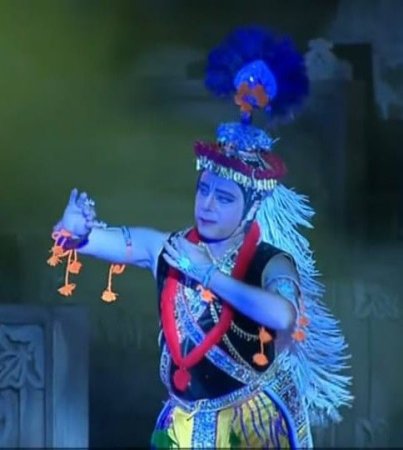 Saptha The next piece called "Saptha" was a pure nritta composition exploring the 7 beat cycle of Tewara, presented by Sanjib. The Khanda of this Taal is 123-45-67 with stresses on 1, 4 and 6. The tandav element was predominant in this piece, with energetic jumps, strong footwork and sharp turns. Darshana Jhaveri mentioned that it was her grand Guru Amudon Sharma's genius to incorporate Cholom movements and create this masculine tandav style, which is the hallmark of his Gharana. Sanjib's agility and intensity proved his mettle as a performer of this unique style. Sanjib is an accomplished artiste, choreographer and teacher with presence across India and the USA. The evening was like a bouquet of surprises. No two pieces presented were alike. Darshana Jhaveri curated the evening with great attention to detail, to make it not only entertaining but also uplifting. The following piece was "Prabandha Swarmala Tanum", a nritta composition performed by Sanjib and Purbita, highlighting the tandav and lasya aspects of Manipuri respectively. They were in perfect sync and regaled the audience with their delightful chemistry on stage. The technical wizardry of Guru Bipin Singh who experimented by incorporating several rhythmic patterns, shone through this piece. 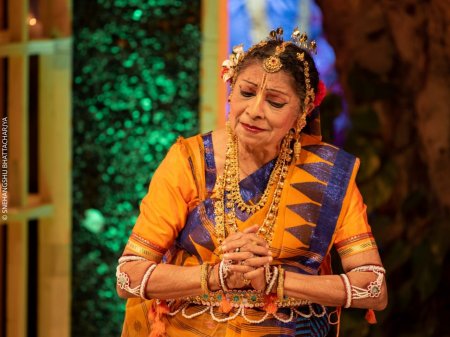 Darshana Jhaveri in Madana Kshepa The next in sequence was "Madana Kshepa", an interesting monologue of sorts by an angered Radha. Performed by Darshana Jhaveri, this piece was a Padaavali (Vaishnavite verse from the Bengal region) wherein Radha confronts Madana, the God of Love. She says that it was Lord Mahadev who burned him to ashes, but he seems to be taking revenge on her by igniting the flames of Viraha / separation in her. She is burning from inside! In her resplendent avatar, Darshana Jhaveri truly came across as Goddess Radha and danced like an Apsara. Her commitment as an artiste is exceptional. She sets an example of how elegant, artistic and sincere one can be - on and off the stage. Given that Manipuri is a temple tradition that has evolved from Kirtan, the role of instrumentation is paramount. The last two pieces were presented with the Manjeera and the Mridang respectively. "Mandila" was performed by Purbita, Jhinuk and Sushmita, with ornate Manjeeras (clash cymbals). They masterfully danced and wielded the cymbals, transporting us to the temples of Manipur. The synchronization was excellent, with not a single beat missed. One must note that the delicate and graceful form of Manipuri, doesn't allow for ghunghroos as they tamper with its innate serenity. But the rasika didn't miss the ghunghroos as the dancers displayed an internalised rhythm and executed complex movements flawlessly. The finale piece was "Mridang Vadan" performed by Sanjib and Sushmita. Darshana Jhaveri explained how women are not allowed to play the drums at the temples, but her gracious Guru ensured they were trained in Pung Cholom from a young age. She expressed with great pride and gratitude, that she was able to perform all the angular jumps and turns in Pung Cholom with ease. She has continued the tradition of training girls in this style. Sanjib and Sushmita's electrifying Mridang Vadan was a befitting finale to the stunning evening of Manipuri. We also had the fortune of watching an archival video of Guru Bipin Singh performing the gaits (Gaman) of different animals and birds such as the elephant, stork, crow, and swan. The audience clapped and expressed awe at his mastery of every minute movement and expression. One must note that in Manipuri, the dancers have subtle and controlled mukha abhinaya, which is a reflection of the innate nature of the people from the region. And yet, they communicate effectively with the audience that becomes drenched in "Rasa Anubhuti". 'Guru Pratistha' was a captivating recital of Manipuri at the NMACC. The famous line in the Guru Stotram goes - "Guruh adiranadishcha Guruh parama daivatam. Guroh parataram nasti tasmai Shri Gurave Namah", meaning the Guru Tattva has no beginning or end. It is eternal and supreme. Guru Darshana Jhaveri and team's 'Guru Pratistha' was the manifestation of this principle in a rare, exquisite presentation of Manipuri. Their Guru Bipin Singh would be smiling from the heavens, watching his priceless legacy in safe hands!  Sumana Sachidananda is a Kathak dancer based in Mumbai. She is an MBA from ISB Hyderabad, and has also trained in Carnatic music. She holds a Senior Diploma in Kathak from Bharatiya Vidya Bhavan and is a DD graded artist. |